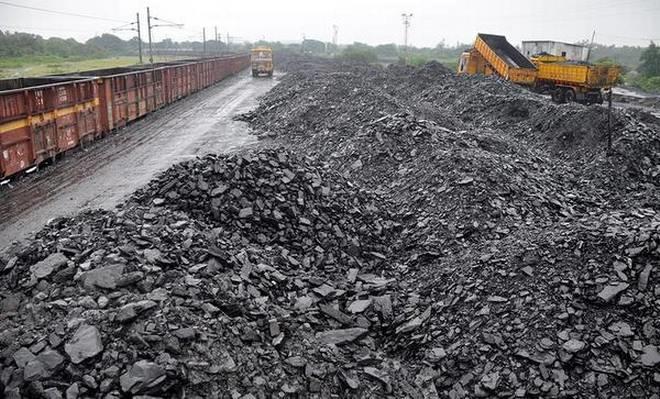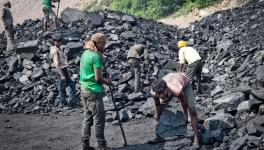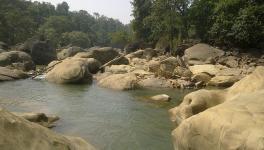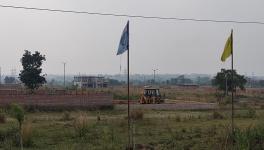Meghalaya Bids Goodbye to Rat-hole Mining, But Systematic Coal Mining Still Far Away

Kolkata: Meghalaya, where coal mining started in 1894, conducted an orientation and sensitisation programme (OSP) for mine owners in the last week of February. This followed the Supreme Court’s order dated July 3, 2019, to facilitate systematic, safe, scientific and planned utilisation of Meghalaya’s mineral resources.
The subjects included in OSP were grant of prospecting licence, preparation of geological report and feasibility study and grant of mining lease in consonance with the Mines and Minerals (Development and Regulation) Act 1957 (MMDR) and the Mineral Concession Rules 1960 (MCR).
The OSP was conducted at Baghmara on February 25 for South Garo Hills, at Nongstoin the next day for West Khasi Hills and at Jowai on February 27 for West Jaintia Hills, according to Meghalaya’s Director of Mineral Resources (DMR) Arunkumar Kembhavi, an IAS officer of the Assam-Meghalaya cadre.
Kembhavi, who is in Shillong, told NewsClick over phone that the state would require at least 18 months to put in place a systematic coal mining regime compatible with the state’s ground realities. But, no less important than that is to live down unscientific, often illegal rat hole coal mining, which was banned by the National Green Tribunal (NGT) on April 17, 2014, citing the environmental degradation that the practice had been causing over the years. “It’s ruled out, it would be a complete break with the past,” the official said.
Also read: Meghalaya Mining Crisis: Illegal, Inhuman, Anti-Ecology
The NGT entered the scene after the Gauhati High Court took suo moto cognisance of the accidents that had occurred on July 6, 2012, and in the course of February 2014. The 2012 tragedy left a total of 15 workers dead. In February 2014 again, four workers lost their lives. The matter was later remitted by the high court to NGT.
The second major step of NGT was to invoke the principle of “polluters pay” and direct that 10% over and above royalty shall be charged for every tonne of coal and receipt thereof shall be deposited in a fund called Meghalaya Environment Protection and Restoration Fund (MEPRF).
As seen from the notes prepared by the Meghalaya government, the intervention by the Gauhati High Court and NGT had accentuated focus on rat hole coal mining and facilitated its becoming an issue of public importance. The following six years saw meetings after meetings held mostly in New Delhi and involving the Prime Minister’s office and ministries of home affairs, coal and mines, and law.
Several of these meetings followed the state chief minister’s letters to the Union government. Executives of Coal India Ltd (CIL) and its wholly-owned subsidiary – the Central Mine Planning and Design Institute (CMPDI) also took part in these meetings.
The key subject was the state’s request, citing its Schedule VI [of the Constitution] status, for exemption from the MMDR Act and related rules or Meghalaya-specific modification through a Presidential notification. The state’s request followed an assessment that given the state-specific ground realities, it did not have effective powers to exercise over coal mining and exemption/modification would be an ideal answer. As is the practice in governments at the Centre and in the states, committees and expert groups were constituted to examine issues.
Also read: Illegal Coal Mining Takes Lives of 2 More in Meghalaya
Certain other developments deserve mention in the context of suggestions and interpretations as to the application of central mining laws in respect of major minerals which include coal. The issues had surfaced after the formation of a separate state of Meghalaya under the Area Reorganisation Act 1971. The developments include:
(1) Referring to traditional mining practices, the then Union energy minister Vasant Sathe in a letter dated July 2, 1987, informed the then Meghalaya chief minister W A Sangma that the Centre had no intention of disturbing the customary tribal rights or causing any hardships to them. The letter also emphasised that traditional mining by the tribal people could continue as per the MMDR Act 1957 and CIL would be willing to give any assistance or advice that the state may require for ensuring scientific mining with due regard for the safety and workers’ health factors. But, in practice, as far as the owners were concerned, the suggestion that the Centre had no intention to disturb customary tribal rights mattered much more than the second suggestion.
(2) In 2012, the state government formulated a coal mining policy with the intention of making it the basis for regulating coal mines.
(3) On March 23, 2015, the Meghalaya Legislative Assembly passed unanimously a resolution urging New Delhi to consider the proposal for exempting the state under paragraph 12A(b) of the sixth schedule from the purview of MMDR Act 1957, MCR 1960 and the Coal Mines (Nationalisation) Act 1973.
Three views which had emerged in the then prevailing state of confusion and conflicting interpretations were: (a) The state contended that it was seeking limited exemption keeping its distinctive features in view and that it was not seeking any relaxation in applying environment-related laws. (b) New Delhi felt the state Assembly had no jurisdiction over a subject in the Union list. (c) New Delhi also felt if Meghalaya’s demand for exemption/modification through Presidential notification was conceded it may have to face similar demands from other states in future.
Also read: Meghalaya Coal Mining: SC Order A Setback for ADCs and Local Coal Lobby
As the twists and turns continued, yet another accident occurred at Ksan -21 in the East Jaintia Hills district on December 13, 2018, in which 15 miners were trapped. And in the course of 2018, a spate of civil appeals were filed in the Supreme Court (SC) and in which the state, a students’ union, an autonomous district council and coordination committee of land owners, miners and traders were parties. Coal mining in Meghalaya once again hogged the limelight as the exercise to recover dead bodies prolonged but with very limited success. However, the SC judgement delivered on July 3, 2019 – by the bench comprising of Justices Ashok Bhushan and K M Joseph – marked a turning point.
Taking note of the nature of land in the state, the apex court found that most of the lands are either privately owned or community owned in Meghalaya’s hill districts and the state does not claim any right in those lands. Thus, private and community owners of the land have both the surface right and sub-soil right. Therefore, tribals owned the land as also the minerals. The court stated, “This is an inescapable ‘conclusion. By raising the demand for exemption under paragraph 12A (b) of the Sixth Schedule, which has not been acceded to by the Centre, the state has recognised that MMDR 1957 is applicable to it. We, thus, conclude there is nothing in the Sixth Schedule ..... which in any manner exclude the applicability of the Act, 1957 .......”
The SC order held that state cannot grant mining lease, as is done in all other states; held that private persons can grant mining lease as per chapter V of the MCR 1960 with prior approval of the Centre, but the application for a lease has to be routed through the state government under Rule 63 of MCR. Thus, SC has ensured a role for the state government. Moreover, there are other MCR Rules which provide for control of the state government in the mining of coal.
The state’s interpretation of the SC verdict is that the highest court has “condoned earlier acts of illegal mining” as the legal regime for regulation was not settled.
Regarding the NGT ban on rat-hole mining, two views deserve mention – first, SC has held that when the prescribed process for obtaining a mining lease and mine plan preparation have been followed, NGT’s ban order dated April 17, 2014, shall not come in the way of carrying mining operations. And NGT itself took the view in its order dated March 31, 2016, that the issue of rat-hole mining has been sorted out by banning the practice.
For commencing scientific coal mining, Meghalaya has begun its exercise to seek assistance of expert organisations, mining research institutes and mining corporations to devise and adopt environmentally sustainable operations, keeping in view the unique characteristics the coal deposits, Kembhavi told NewsClick. It may take at least 18 months or so to put the new system in place, he added and said that a small beginning has been made with the issuance of a prospecting licence.
Also read: International Award, Accolades for Meghalaya Activists, But no Justice at Home
As for involving state public sector undertakings, the name of Meghalaya Mineral development Corporation figured at a meeting called by the Coal Ministry on January 30, 2017. The issue was whether a state enterprise and local land owners/communities can work together through shareholder arrangements or profit sharing contractual arrangements. It remains to be seen whether the proposal is proceeded with further.
For the record, it may be mentioned that the Meghalaya coal is known as ‘Tertiary coal’. Its ash content is lower than that of the best quality in the country. Its calorific value exceeds that of some of the best grade coal. But, its greatest drawback is its high sulphur content, which makes it a highly polluting fuel. The coal is mostly sub-bituminous type.
The rat-hole practice, it would appear, gained currency as the coal seams are quite thin; undulating topography prevents their attaining thickness. Those are also not continuous, but have swelling and pinching character. The practice involves felling of trees till seams are reached, making three-four feet high tunnels and finally extracting coal.
Get the latest reports & analysis with people's perspective on Protests, movements & deep analytical videos, discussions of the current affairs in your Telegram app. Subscribe to NewsClick's Telegram channel & get Real-Time updates on stories, as they get published on our website.
























